Introduction to Human Resource Management & Talent Report
VerifiedAdded on 2023/01/11
|7
|1336
|23
Report
AI Summary
This report provides an overview of key concepts in Human Resource Management (HRM). It discusses the importance of training evaluation within organizations and highlights the factors that influence its effectiveness. The report also delves into the significance of recruitment and selection policies, emphasizing the role of HRM in managing these processes and the importance of attracting and retaining skilled employees. Furthermore, it explores process theories of motivation, including the goal-setting theory, equity theory, and expectancy theory, explaining how these theories can be applied to motivate employees in the workplace. The report concludes by emphasizing the importance of effective HRM practices and the use of motivation theories to build a productive workforce.
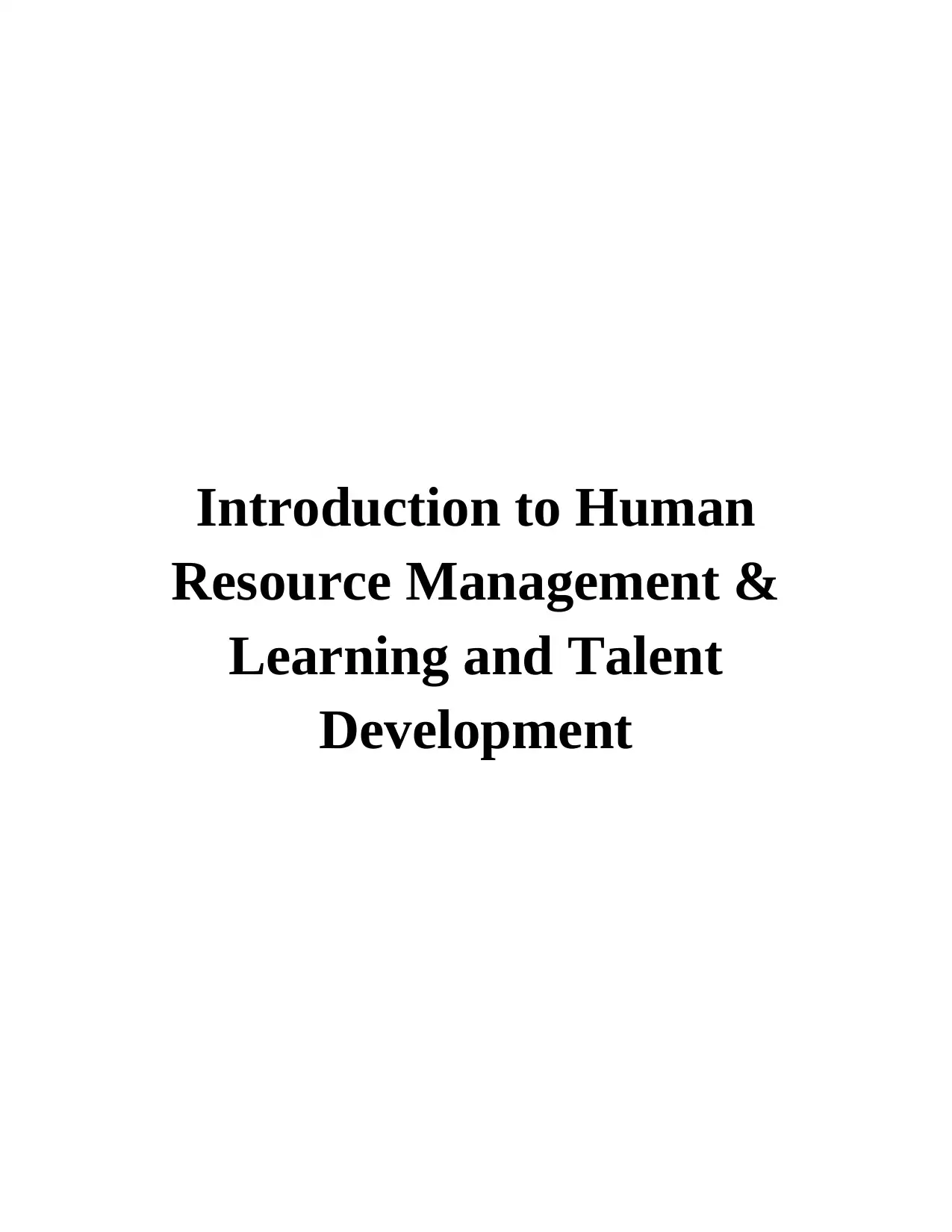
Introduction to Human
Resource Management &
Learning and Talent
Development
Resource Management &
Learning and Talent
Development
Paraphrase This Document
Need a fresh take? Get an instant paraphrase of this document with our AI Paraphraser
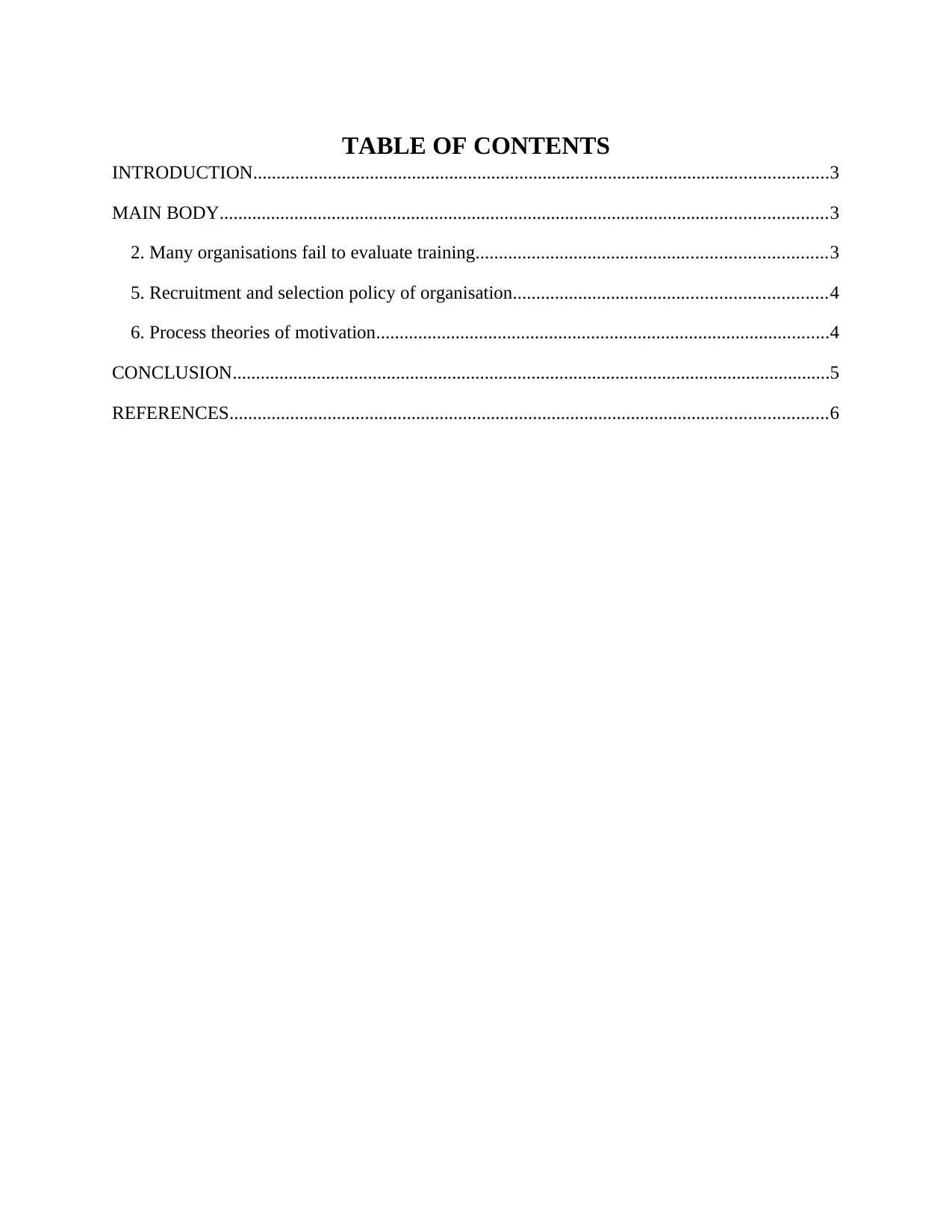
TABLE OF CONTENTS
INTRODUCTION...........................................................................................................................3
MAIN BODY..................................................................................................................................3
2. Many organisations fail to evaluate training...........................................................................3
5. Recruitment and selection policy of organisation...................................................................4
6. Process theories of motivation.................................................................................................4
CONCLUSION................................................................................................................................5
REFERENCES................................................................................................................................6
INTRODUCTION...........................................................................................................................3
MAIN BODY..................................................................................................................................3
2. Many organisations fail to evaluate training...........................................................................3
5. Recruitment and selection policy of organisation...................................................................4
6. Process theories of motivation.................................................................................................4
CONCLUSION................................................................................................................................5
REFERENCES................................................................................................................................6
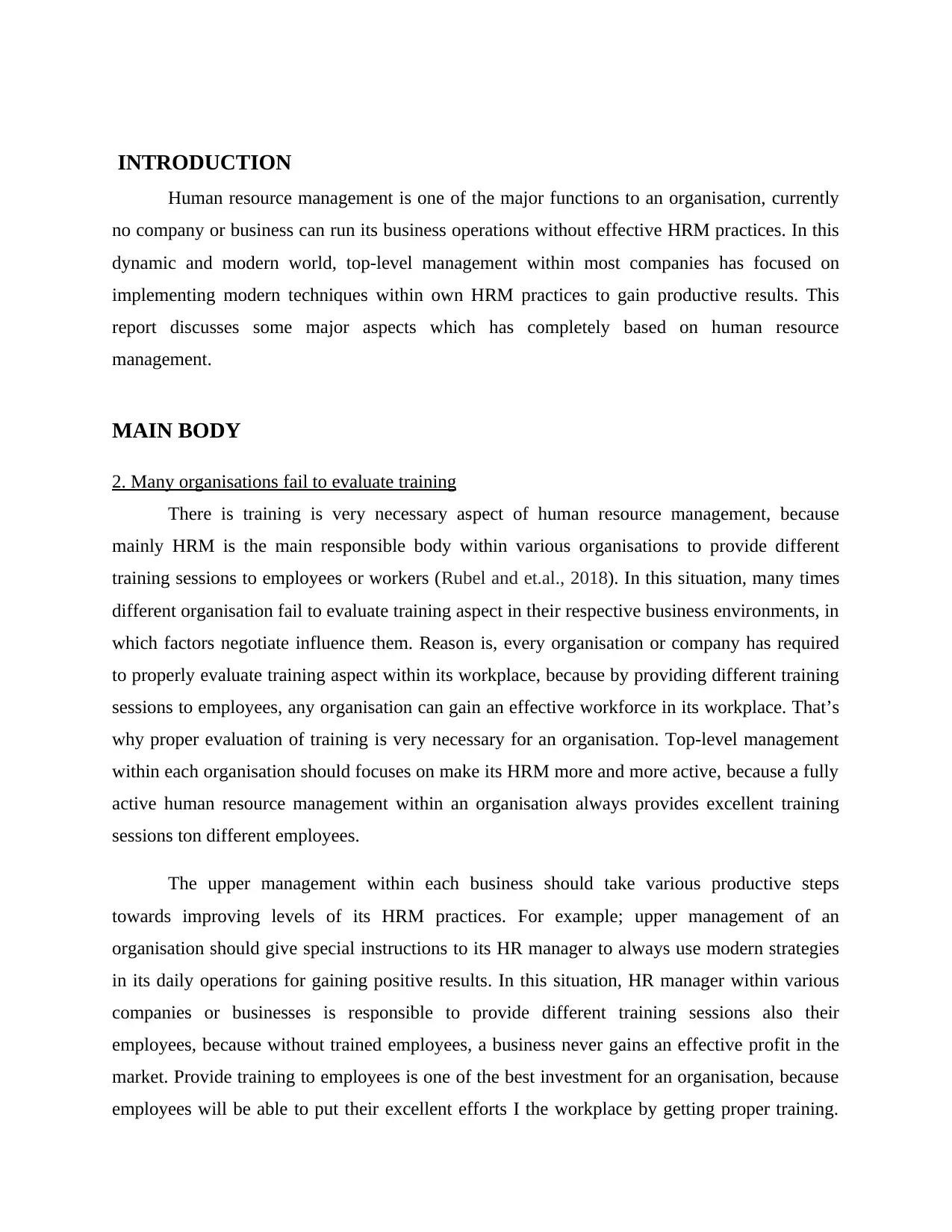
INTRODUCTION
Human resource management is one of the major functions to an organisation, currently
no company or business can run its business operations without effective HRM practices. In this
dynamic and modern world, top-level management within most companies has focused on
implementing modern techniques within own HRM practices to gain productive results. This
report discusses some major aspects which has completely based on human resource
management.
MAIN BODY
2. Many organisations fail to evaluate training
There is training is very necessary aspect of human resource management, because
mainly HRM is the main responsible body within various organisations to provide different
training sessions to employees or workers (Rubel and et.al., 2018). In this situation, many times
different organisation fail to evaluate training aspect in their respective business environments, in
which factors negotiate influence them. Reason is, every organisation or company has required
to properly evaluate training aspect within its workplace, because by providing different training
sessions to employees, any organisation can gain an effective workforce in its workplace. That’s
why proper evaluation of training is very necessary for an organisation. Top-level management
within each organisation should focuses on make its HRM more and more active, because a fully
active human resource management within an organisation always provides excellent training
sessions ton different employees.
The upper management within each business should take various productive steps
towards improving levels of its HRM practices. For example; upper management of an
organisation should give special instructions to its HR manager to always use modern strategies
in its daily operations for gaining positive results. In this situation, HR manager within various
companies or businesses is responsible to provide different training sessions also their
employees, because without trained employees, a business never gains an effective profit in the
market. Provide training to employees is one of the best investment for an organisation, because
employees will be able to put their excellent efforts I the workplace by getting proper training.
Human resource management is one of the major functions to an organisation, currently
no company or business can run its business operations without effective HRM practices. In this
dynamic and modern world, top-level management within most companies has focused on
implementing modern techniques within own HRM practices to gain productive results. This
report discusses some major aspects which has completely based on human resource
management.
MAIN BODY
2. Many organisations fail to evaluate training
There is training is very necessary aspect of human resource management, because
mainly HRM is the main responsible body within various organisations to provide different
training sessions to employees or workers (Rubel and et.al., 2018). In this situation, many times
different organisation fail to evaluate training aspect in their respective business environments, in
which factors negotiate influence them. Reason is, every organisation or company has required
to properly evaluate training aspect within its workplace, because by providing different training
sessions to employees, any organisation can gain an effective workforce in its workplace. That’s
why proper evaluation of training is very necessary for an organisation. Top-level management
within each organisation should focuses on make its HRM more and more active, because a fully
active human resource management within an organisation always provides excellent training
sessions ton different employees.
The upper management within each business should take various productive steps
towards improving levels of its HRM practices. For example; upper management of an
organisation should give special instructions to its HR manager to always use modern strategies
in its daily operations for gaining positive results. In this situation, HR manager within various
companies or businesses is responsible to provide different training sessions also their
employees, because without trained employees, a business never gains an effective profit in the
market. Provide training to employees is one of the best investment for an organisation, because
employees will be able to put their excellent efforts I the workplace by getting proper training.
⊘ This is a preview!⊘
Do you want full access?
Subscribe today to unlock all pages.

Trusted by 1+ million students worldwide
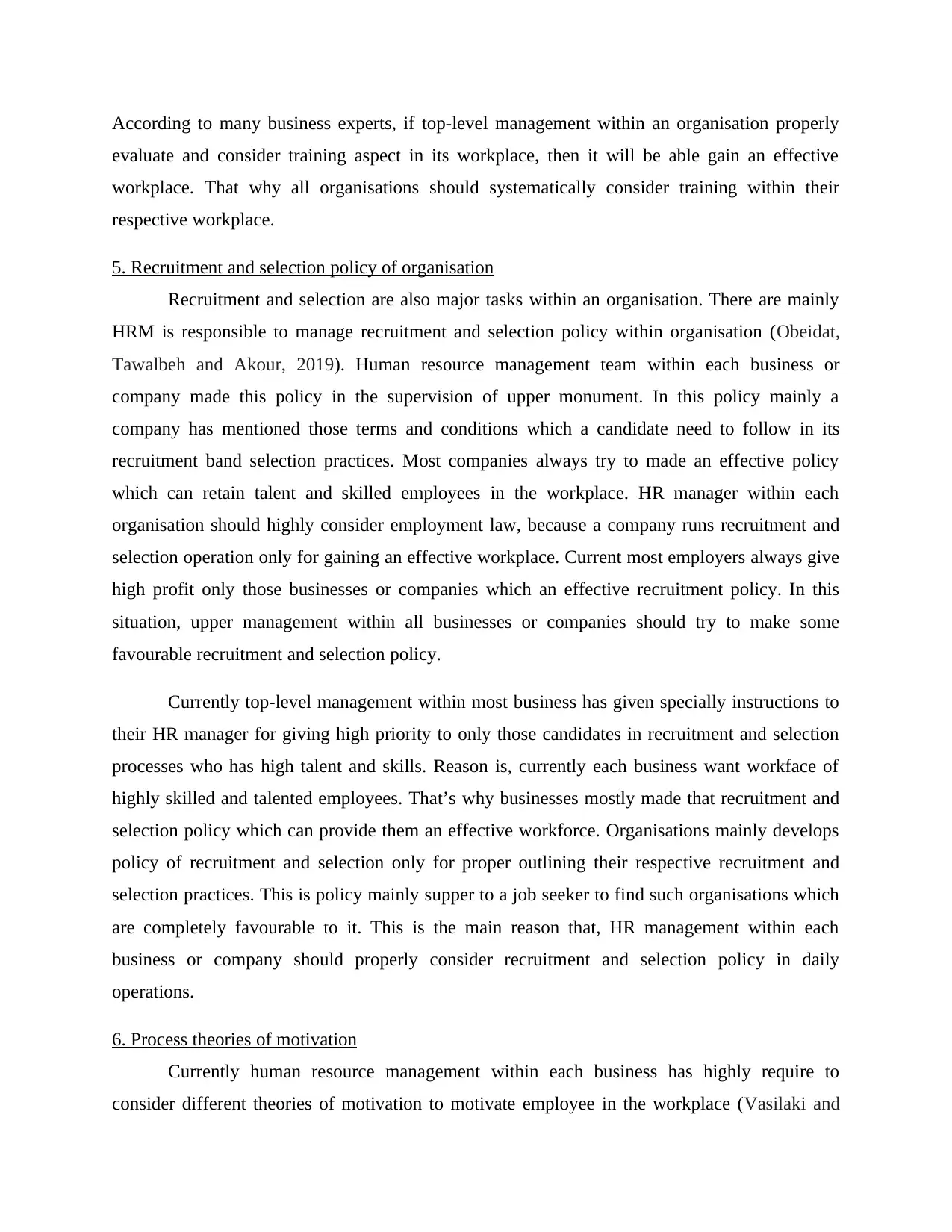
According to many business experts, if top-level management within an organisation properly
evaluate and consider training aspect in its workplace, then it will be able gain an effective
workplace. That why all organisations should systematically consider training within their
respective workplace.
5. Recruitment and selection policy of organisation
Recruitment and selection are also major tasks within an organisation. There are mainly
HRM is responsible to manage recruitment and selection policy within organisation (Obeidat,
Tawalbeh and Akour, 2019). Human resource management team within each business or
company made this policy in the supervision of upper monument. In this policy mainly a
company has mentioned those terms and conditions which a candidate need to follow in its
recruitment band selection practices. Most companies always try to made an effective policy
which can retain talent and skilled employees in the workplace. HR manager within each
organisation should highly consider employment law, because a company runs recruitment and
selection operation only for gaining an effective workplace. Current most employers always give
high profit only those businesses or companies which an effective recruitment policy. In this
situation, upper management within all businesses or companies should try to make some
favourable recruitment and selection policy.
Currently top-level management within most business has given specially instructions to
their HR manager for giving high priority to only those candidates in recruitment and selection
processes who has high talent and skills. Reason is, currently each business want workface of
highly skilled and talented employees. That’s why businesses mostly made that recruitment and
selection policy which can provide them an effective workforce. Organisations mainly develops
policy of recruitment and selection only for proper outlining their respective recruitment and
selection practices. This is policy mainly supper to a job seeker to find such organisations which
are completely favourable to it. This is the main reason that, HR management within each
business or company should properly consider recruitment and selection policy in daily
operations.
6. Process theories of motivation
Currently human resource management within each business has highly require to
consider different theories of motivation to motivate employee in the workplace (Vasilaki and
evaluate and consider training aspect in its workplace, then it will be able gain an effective
workplace. That why all organisations should systematically consider training within their
respective workplace.
5. Recruitment and selection policy of organisation
Recruitment and selection are also major tasks within an organisation. There are mainly
HRM is responsible to manage recruitment and selection policy within organisation (Obeidat,
Tawalbeh and Akour, 2019). Human resource management team within each business or
company made this policy in the supervision of upper monument. In this policy mainly a
company has mentioned those terms and conditions which a candidate need to follow in its
recruitment band selection practices. Most companies always try to made an effective policy
which can retain talent and skilled employees in the workplace. HR manager within each
organisation should highly consider employment law, because a company runs recruitment and
selection operation only for gaining an effective workplace. Current most employers always give
high profit only those businesses or companies which an effective recruitment policy. In this
situation, upper management within all businesses or companies should try to make some
favourable recruitment and selection policy.
Currently top-level management within most business has given specially instructions to
their HR manager for giving high priority to only those candidates in recruitment and selection
processes who has high talent and skills. Reason is, currently each business want workface of
highly skilled and talented employees. That’s why businesses mostly made that recruitment and
selection policy which can provide them an effective workforce. Organisations mainly develops
policy of recruitment and selection only for proper outlining their respective recruitment and
selection practices. This is policy mainly supper to a job seeker to find such organisations which
are completely favourable to it. This is the main reason that, HR management within each
business or company should properly consider recruitment and selection policy in daily
operations.
6. Process theories of motivation
Currently human resource management within each business has highly require to
consider different theories of motivation to motivate employee in the workplace (Vasilaki and
Paraphrase This Document
Need a fresh take? Get an instant paraphrase of this document with our AI Paraphraser
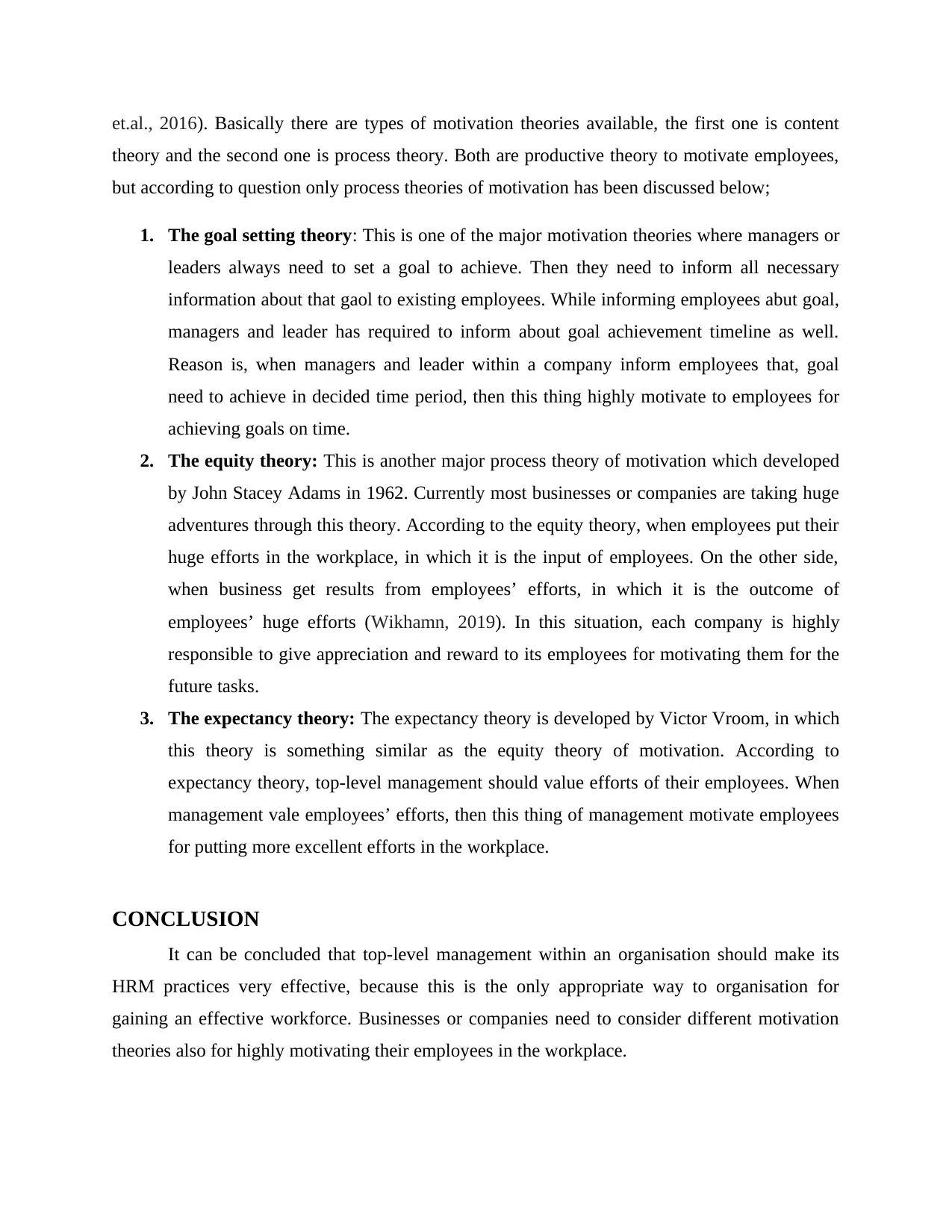
et.al., 2016). Basically there are types of motivation theories available, the first one is content
theory and the second one is process theory. Both are productive theory to motivate employees,
but according to question only process theories of motivation has been discussed below;
1. The goal setting theory: This is one of the major motivation theories where managers or
leaders always need to set a goal to achieve. Then they need to inform all necessary
information about that gaol to existing employees. While informing employees abut goal,
managers and leader has required to inform about goal achievement timeline as well.
Reason is, when managers and leader within a company inform employees that, goal
need to achieve in decided time period, then this thing highly motivate to employees for
achieving goals on time.
2. The equity theory: This is another major process theory of motivation which developed
by John Stacey Adams in 1962. Currently most businesses or companies are taking huge
adventures through this theory. According to the equity theory, when employees put their
huge efforts in the workplace, in which it is the input of employees. On the other side,
when business get results from employees’ efforts, in which it is the outcome of
employees’ huge efforts (Wikhamn, 2019). In this situation, each company is highly
responsible to give appreciation and reward to its employees for motivating them for the
future tasks.
3. The expectancy theory: The expectancy theory is developed by Victor Vroom, in which
this theory is something similar as the equity theory of motivation. According to
expectancy theory, top-level management should value efforts of their employees. When
management vale employees’ efforts, then this thing of management motivate employees
for putting more excellent efforts in the workplace.
CONCLUSION
It can be concluded that top-level management within an organisation should make its
HRM practices very effective, because this is the only appropriate way to organisation for
gaining an effective workforce. Businesses or companies need to consider different motivation
theories also for highly motivating their employees in the workplace.
theory and the second one is process theory. Both are productive theory to motivate employees,
but according to question only process theories of motivation has been discussed below;
1. The goal setting theory: This is one of the major motivation theories where managers or
leaders always need to set a goal to achieve. Then they need to inform all necessary
information about that gaol to existing employees. While informing employees abut goal,
managers and leader has required to inform about goal achievement timeline as well.
Reason is, when managers and leader within a company inform employees that, goal
need to achieve in decided time period, then this thing highly motivate to employees for
achieving goals on time.
2. The equity theory: This is another major process theory of motivation which developed
by John Stacey Adams in 1962. Currently most businesses or companies are taking huge
adventures through this theory. According to the equity theory, when employees put their
huge efforts in the workplace, in which it is the input of employees. On the other side,
when business get results from employees’ efforts, in which it is the outcome of
employees’ huge efforts (Wikhamn, 2019). In this situation, each company is highly
responsible to give appreciation and reward to its employees for motivating them for the
future tasks.
3. The expectancy theory: The expectancy theory is developed by Victor Vroom, in which
this theory is something similar as the equity theory of motivation. According to
expectancy theory, top-level management should value efforts of their employees. When
management vale employees’ efforts, then this thing of management motivate employees
for putting more excellent efforts in the workplace.
CONCLUSION
It can be concluded that top-level management within an organisation should make its
HRM practices very effective, because this is the only appropriate way to organisation for
gaining an effective workforce. Businesses or companies need to consider different motivation
theories also for highly motivating their employees in the workplace.

⊘ This is a preview!⊘
Do you want full access?
Subscribe today to unlock all pages.

Trusted by 1+ million students worldwide
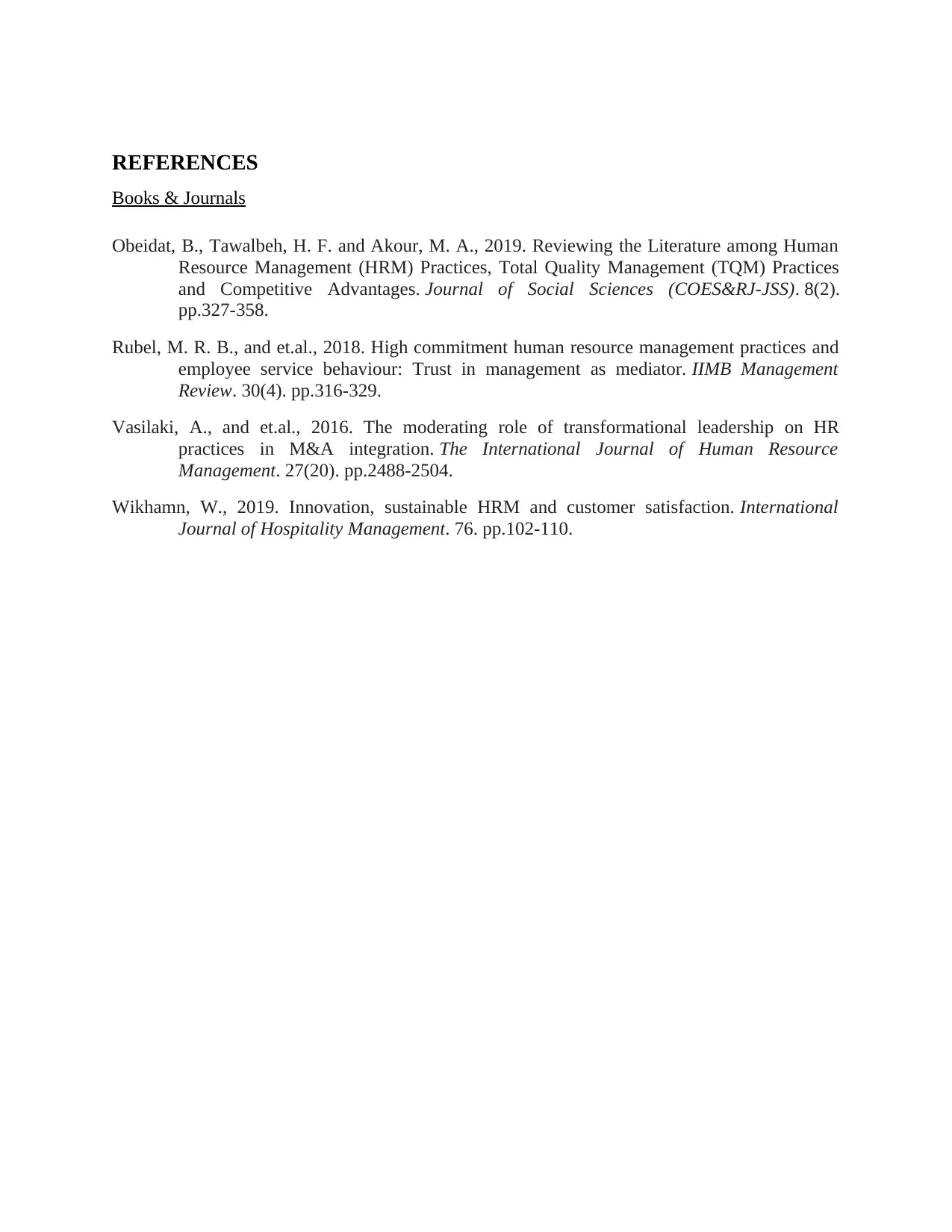
REFERENCES
Books & Journals
Obeidat, B., Tawalbeh, H. F. and Akour, M. A., 2019. Reviewing the Literature among Human
Resource Management (HRM) Practices, Total Quality Management (TQM) Practices
and Competitive Advantages. Journal of Social Sciences (COES&RJ-JSS). 8(2).
pp.327-358.
Rubel, M. R. B., and et.al., 2018. High commitment human resource management practices and
employee service behaviour: Trust in management as mediator. IIMB Management
Review. 30(4). pp.316-329.
Vasilaki, A., and et.al., 2016. The moderating role of transformational leadership on HR
practices in M&A integration. The International Journal of Human Resource
Management. 27(20). pp.2488-2504.
Wikhamn, W., 2019. Innovation, sustainable HRM and customer satisfaction. International
Journal of Hospitality Management. 76. pp.102-110.
Books & Journals
Obeidat, B., Tawalbeh, H. F. and Akour, M. A., 2019. Reviewing the Literature among Human
Resource Management (HRM) Practices, Total Quality Management (TQM) Practices
and Competitive Advantages. Journal of Social Sciences (COES&RJ-JSS). 8(2).
pp.327-358.
Rubel, M. R. B., and et.al., 2018. High commitment human resource management practices and
employee service behaviour: Trust in management as mediator. IIMB Management
Review. 30(4). pp.316-329.
Vasilaki, A., and et.al., 2016. The moderating role of transformational leadership on HR
practices in M&A integration. The International Journal of Human Resource
Management. 27(20). pp.2488-2504.
Wikhamn, W., 2019. Innovation, sustainable HRM and customer satisfaction. International
Journal of Hospitality Management. 76. pp.102-110.
1 out of 7
Related Documents
Your All-in-One AI-Powered Toolkit for Academic Success.
+13062052269
info@desklib.com
Available 24*7 on WhatsApp / Email
![[object Object]](/_next/static/media/star-bottom.7253800d.svg)
Unlock your academic potential
Copyright © 2020–2025 A2Z Services. All Rights Reserved. Developed and managed by ZUCOL.





